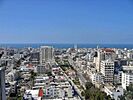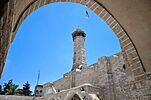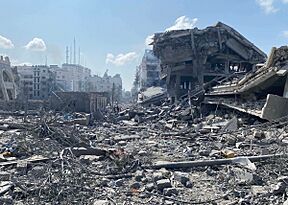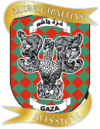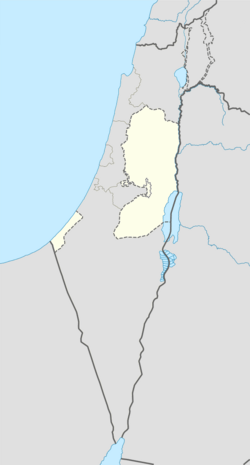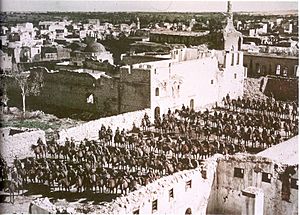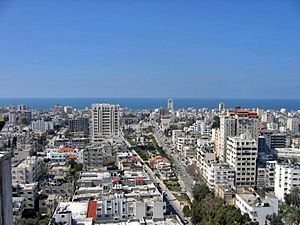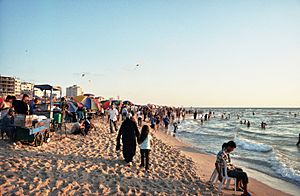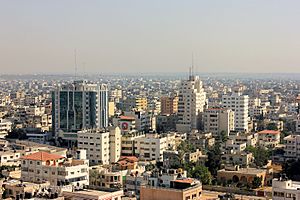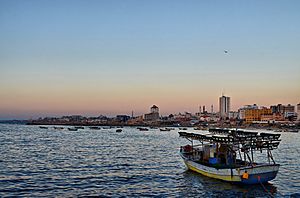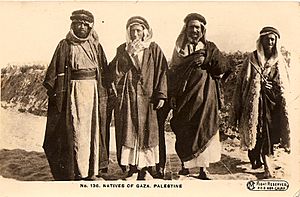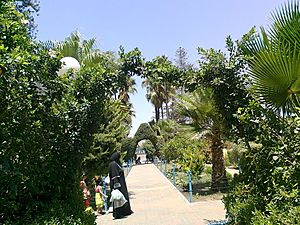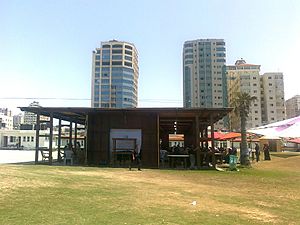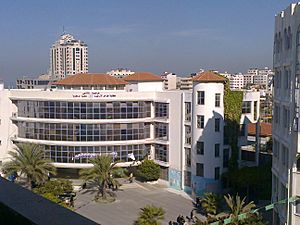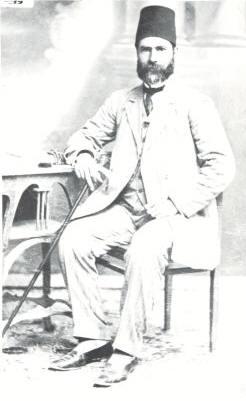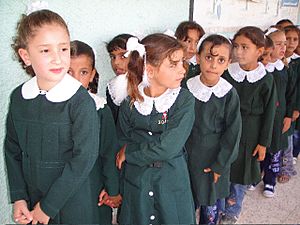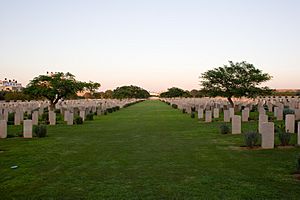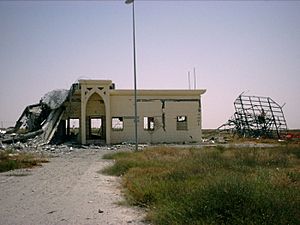Gaza City facts for kids
Quick facts for kids
Gaza
غَزَّة
Gaza City
|
||
|---|---|---|
|
Municipality type A (City)
|
||
| Arabic transcription(s) | ||
| • Latin (official) | Ghazzah | |
| • Latin (DIN 31635) | Ġazzah | |
|
Rimal before October 2023
Skyline of Gaza City, October 2023
|
||
|
||
| Country | ||
| Governorate | Gaza | |
| Founded | 15th century BC | |
| Government | ||
| • Type | City (from 1994) | |
| Area | ||
| • Total | 45,000 dunams (45 km2 or 17 sq mi) | |
| Population
(2017 Census)
|
||
| • Total | 590,481 | |
| • Density | 13,120/km2 (34,000/sq mi) | |
| Website | mogaza.org | |
Gaza, also known as Gaza City, is a city located in the Gaza Strip, Palestine. In 2017, it had about 590,481 people living there. It is the largest city in the State of Palestine. The city covers an area of 45 square kilometers (17 square miles). Gaza is an important coastal city and has Palestine's only port. It is located on the coast of the Mediterranean Sea.
Gaza has been lived in for a very long time, since at least the 15th century BC. Many different groups have ruled it throughout history. The Philistines made it part of their "pentapolis" (a group of five cities) after the ancient Egyptians ruled it for about 350 years. Under the Roman Empire, Gaza was peaceful and its port grew. In 635 AD, it became the first city in the Palestine region to be taken by the Rashidun army. It quickly became a center for Islamic law.
Later, Gaza faced many challenges, including Mongol raids and floods. By the 16th century, it was a small village when it became part of the Ottoman Empire. During the first part of Ottoman rule, the Ridwan dynasty controlled Gaza. The city became a busy place for trade and was peaceful. The city government of Gaza was set up in 1893.
Gaza was taken by British forces during World War I. It became part of Mandatory Palestine. After the 1948 Arab–Israeli War, Egypt managed the new Gaza Strip. Many improvements were made in the city. In 1967, Israel took control of Gaza during the Six-Day War. In 1993, the city was given to the new Palestinian National Authority. After the 2006 election, there was a conflict between Palestinian groups Fatah and Hamas. Hamas took control of Gaza. The Gaza Strip then faced a blockade led by Israel and supported by Egypt.
Gaza's main economic activities are small industries and agriculture. However, the blockade and ongoing conflicts have made the economy very difficult. Most people in Gaza are Muslim, but there is also a small Christian minority. Gaza has a very young population, with about 75% of people under 25 years old. The city is currently managed by a 14-member city council controlled by Hamas.
As of late 2023 and early 2024, during the 2023 Israel–Hamas war, large parts of Gaza City were damaged. Many buildings and important structures were destroyed. Most residents have moved to other areas in Southern Gaza or have been affected by the conflict. This means that older population numbers are no longer accurate. The city has faced a severe humanitarian crisis.
Contents
- What Does the Name Gaza Mean?
- A Look at Gaza's Long History
- Early Settlements and Ancient Empires
- Gaza in the Iron Age
- From Israelite to Persian Rule
- The Hellenistic Period and Alexander the Great
- Gaza Under Roman Rule
- The Byzantine Era
- Early Islamic Period
- Crusader and Ayyubid Periods
- Mamluk Rule and Revival
- The Ottoman Period
- Modern Conflicts and Changes
- Palestinian Control and Recent Events
- Where is Gaza Located?
- Who Lives in Gaza?
- How Does Gaza's Economy Work?
- Gaza's Culture and Traditions
- How Gaza is Governed
- Learning and Education in Gaza
- Important Places to See in Gaza
- City Services and Infrastructure
- Getting Around Gaza
- Gaza's International Connections
- See Also
What Does the Name Gaza Mean?
The name Gaza first appeared in Egyptian military records in the 15th century BC. In ancient texts from the Neo-Assyrian period, it was called Hāzat.
In Semitic languages, the name of the city means "fierce" or "strong." The Hebrew name for the city is ʿAzza.
Some historians say the Ancient Egyptians called it gḏt, meaning "prized city." Muslims often called it Ghazzat Hashem to honor Hashim ibn Abd Manaf. He was the great-grandfather of Muhammad and is believed to be buried in the city.
A Look at Gaza's Long History
Gaza has been continuously inhabited for 5,000 years, making it one of the oldest cities in the world. It was located on an important coastal trade route between North Africa and the Levant. For much of its history, it was a key trading center and a stop on the spice trade route.
Early Settlements and Ancient Empires
The first settlements in the Gaza area date back to an ancient Egyptian fort. This fort was built in Canaanite land south of today's Gaza. Another city, Tell el-Ajjul, grew along the Wadi Ghazza river.
During the Middle Bronze Age, a rebuilt fort at Tell es-Sakan became the southernmost point in Palestine. Around 1650 BC, when the Hyksos people from Canaan took over Egypt, a second city developed there.
Under Tuthmosis III (who ruled from 1479–1425 BC), Gaza became a stop on the trade route between Syria and Egypt. It was mentioned in ancient letters as "Azzati." Gaza remained under Egyptian control for 350 years. Then, the Philistines conquered it in the 12th century BC.
Gaza in the Iron Age
In the 12th century BC, Gaza became part of the Philistine "pentapolis", a group of five important cities.
The Hebrew Bible's Book of Judges tells the story of Samson. It says Gaza was where Samson was held prisoner by the Philistines and where he died.
From Israelite to Persian Rule
After being ruled by the Israelites, Assyrians, and Egyptians, Gaza gained some independence. It became prosperous under the Persian Empire.
The Hellenistic Period and Alexander the Great
Alexander the Great besieged Gaza in 332 BC. It was the last city to resist his conquest on his way to Egypt. He captured it after five months. Alexander brought in local people to live in Gaza and organized it as a polis (a city-state).
Later, during the Seleucid period, Gaza was renamed Seleucia to help control the area. Greek culture became strong in Gaza, and it was known as a center for learning and philosophy.
Gaza faced another siege in 96 BC by the Hasmonean king Alexander Jannaeus. He "completely destroyed" the city.
Gaza Under Roman Rule
Gaza was rebuilt after it became part of the Roman Empire in 63 BC. It was then part of the Roman province of Judaea. It was damaged during Jewish rebellions against Roman rule. However, it remained an important city, especially after Jerusalem was destroyed.
Throughout the Roman period, Gaza was a wealthy city. A senate of 500 members governed it. Many different groups of people lived there, including Greeks, Romans, Jews, and Egyptians. Gaza's mint made coins with images of Roman gods and emperors. Christianity began to spread in Gaza around 250 AD.
The Byzantine Era
After the Roman Empire split, Gaza remained under the control of the Eastern Roman Empire, which became the Byzantine Empire. The city continued to thrive. A Christian bishopric was set up in Gaza. Many people converted to Christianity. In 402, all eight of the city's pagan temples were ordered to be destroyed. A church was built on the ruins of one temple.
Early Islamic Period
Around 638 AD, Arab Muslim forces captured Gaza. The city was not destroyed, and its people were not harmed, though the Byzantine soldiers were defeated.
The arrival of Muslims brought big changes. Some churches became mosques, including the Great Mosque of Gaza. This mosque was later rebuilt by Sultan Baibars. Many people quickly became Muslim, and Arabic became the main language. In 767, Muhammad ibn Idris ash-Shafi'i was born in Gaza. He founded one of the four main schools of Islamic law.
Gaza was sometimes attacked by nomadic groups because it was near the desert. In 796, it was destroyed during a civil war. However, by the 10th century, the city was rebuilt. A geographer described Gaza as "a large town lying on the highroad to Egypt."
Crusader and Ayyubid Periods
The Crusaders took Gaza in 1100. King Baldwin III built a castle there in 1149. He also turned the Great Mosque back into a church. In 1187, the Ayyubids, led by Sultan Saladin, captured Gaza. They destroyed the city's defenses. Ayyubid rule ended in 1260 after the Mongols completely destroyed Gaza.
Mamluk Rule and Revival
After the Mongols, Muslim slave-soldiers called the Mamluks took control. In 1277, Gaza became the capital of a province named after it. Gaza entered a peaceful time under the Mamluks. In 1294, an earthquake hit Gaza. Five years later, the Mongols destroyed the city again.
Under Emir Sanjar al-Jawli, Gaza became a thriving city. Many buildings from the Mamluk era were built during his rule. In 1348, the bubonic plague (a serious disease) spread to the city, killing most of its people. In 1352, Gaza suffered from a destructive flood. However, when a traveler visited in 1355, he noted that it was "large and populous." The Mamluks built mosques, Islamic colleges, hospitals, and public baths.
The Mamluks allowed Jews to return to the city. The Jewish community grew during Mamluk rule. By the end of this period, Gaza had the third-largest Jewish community in Palestine.
The Ottoman Period

In 1516, Gaza became part of the Ottoman Empire. At that time, it was a small town with little trade. The local people generally welcomed the Ottomans. Gaza became the capital of the Gaza Sanjak. The Ridwan family governed Gaza for over a century. Under their rule, Gaza became a cultural and religious center.
This period is called a golden age for Gaza. The Great Mosque was repaired, and six new mosques were built. Turkish baths and markets also grew. After the Ridwan family left power, the city slowly declined.
In the early 19th century, Gaza was influenced by Egypt. Muhammad Ali of Egypt conquered Gaza in 1832. An American scholar visited in 1838 and described it as a "thickly populated" town, larger than Jerusalem. Gaza benefited from trade because of its location on the caravan route. Its markets were well-stocked.
The bubonic plague struck Gaza again in 1839. In 1840, Egyptian and Ottoman troops fought outside Gaza. The Ottomans won, ending Egyptian rule. But the battles caused more damage to the city.
Modern Conflicts and Changes
During World War I, British forces took control of Gaza in 1917. After the war, Gaza became part of Mandatory Palestine. In the 1930s and 1940s, Gaza grew a lot. New neighborhoods were built, often funded by international groups.
In 1947, the United Nations Partition Plan suggested Gaza be part of an Arab state. However, after the 1948 Arab–Israeli War, Egypt took control of the Gaza Strip. Many refugees came to Gaza, increasing its population.
Israel occupied Gaza during the 1967 Six-Day War. Conflicts between Palestinians and Israeli authorities increased from the 1970s. This led to the First Intifada in 1987, an uprising where Gaza was a center of protests.
Palestinian Control and Recent Events
In 1993, Israel and the Palestine Liberation Organization (PLO) signed the Oslo Accords. This agreement led to Palestinian control of the Gaza Strip. Israeli forces left Gaza in 1994, and the new Palestinian National Authority (PNA) took over. Gaza became its first headquarters.
In 2005, Israel withdrew its troops and settlers from the Gaza Strip. After this, Hamas and Fatah had a power struggle. In 2006, Hamas won the elections. In 2007, Hamas overthrew Fatah forces in Gaza. Since then, Hamas has controlled the city and the Strip.
In 2008, human rights groups reported that the Israeli blockade of Gaza had caused a difficult situation for people. In 2008, Israel began an assault against Gaza. This was in response to rocket attacks. In 2009, many Palestinians were killed in the conflict.
In November 2012, a ceasefire was announced after a week of conflict. In the 2014 Israel–Gaza conflict, many Palestinians and Israelis were killed. In 2021, a 13-story building in Gaza was destroyed by an Israeli airstrike.
In 2023, the city was again heavily impacted during the Israel–Hamas war. The siege of Gaza City began on November 2. As of early 2024, much of northern Gaza, including Gaza City, has been damaged or destroyed. Many residents have had to leave their homes and move to southern Gaza. The remaining population faces a severe lack of food and supplies.
Where is Gaza Located?
Central Gaza is on a low, round hill about 14 meters (46 feet) above sea level. Much of the modern city is built on the flat land around this hill. The beach and port are 3 kilometers (1.9 miles) west of the city center.
Gaza's city area is about 45 square kilometers (17 square miles). It is 78 kilometers (48 miles) southwest of Jerusalem and 71 kilometers (44 miles) south of Tel Aviv. Nearby towns include Beit Lahia and Jabalia to the north.
The people of Gaza rely on groundwater for drinking, farming, and daily use. The nearest stream, Wadi Ghazza, only carries a small amount of water in winter. Most of Gaza's water supply is sent to Israel. The Gaza Aquifer is the main source of water.
A hill southeast of Gaza, Tell al-Muntar, is 270 feet (82 meters) above sea level. It is believed to be where Samson brought the city gates of the Philistines. A Muslim shrine is on top of the hill.
Exploring Gaza's Old City
The Old City is the main historical part of Gaza. It is divided into two areas: the northern Daraj Quarter and the southern Zaytun Quarter. Most buildings are from the Mamluk and Ottoman periods. The ancient part of the Old City is about 1.6 square kilometers (0.62 square miles).
The Old City used to have seven historic gates. Some old buildings use the ablaq style, which has alternating layers of red and white stone. Daraj Quarter has the Gold (Qissariya) Market, the Great Mosque of Gaza, and the Sayed al-Hashim Mosque. In Zaytun Quarter, you can find the Saint Porphryrius Church, the Katib al-Wilaya Mosque, and Hamam as-Sammara (the "Samaritan's Bathhouse").
City Districts and Neighborhoods
Gaza has thirteen districts outside the Old City. The first area built outside the center was Shuja'iyya, during the Ayyubid period. In the northeast is Tuffah, from the Mamluk era.
In the 1930s and 1940s, new residential areas like Rimal were built west of the city center. Zeitoun was built along Gaza's southern borders. The Judeide and Turukman neighborhoods also expanded.
The areas between Rimal and the Old City became the districts of Sabra and Daraj. In the northwest is Nasser, named after Egyptian president Gamal Abdel Nasser. Sheikh Radwan, developed in the 1970s, is 3 kilometers (1.9 miles) north of the Old City. Gaza has also grown to include the village of al-Qubbah and the Palestinian refugee camp of al-Shati. In the late 1990s, a newer neighborhood called Tel al-Hawa was built.
Gaza's Climate
Gaza has a hot, semi-dry climate. It has mild, rainy winters and dry, hot summers. Spring arrives around March or April. August is the hottest month, with an average high of 31.7°C (89.1°F). January is the coolest month, with temperatures usually around 18.3°C (64.9°F). Rain is rare and mostly falls between November and March.
Who Lives in Gaza?
| Year | Population |
|---|---|
| 1596 | 6,000 |
| 1838 | 15,000–16,000 |
| 1882 | 16,000 |
| 1897 | 36,000 |
| 1906 | 40,000 |
| 1914 | 42,000 |
| 1922 | 17,480 |
| 1931 | 17,046 |
| 1945 | 34,250 |
| 1982 | 100,272 |
| 1997 | 306,113 |
| 2007 | 449,221 |
| 2012 | 590,481 |
In 1596, about 6,000 people lived in Gaza. This made it the third largest city in Ottoman Palestine. By 1838, the population had grown to about 15,000 or 16,000. Before World War I, Gaza had 42,000 people. However, battles in 1917 caused a big drop in population.
After the 1948 Arab–Israeli War, many Palestinian refugees came to Gaza. This greatly increased the population. By 1967, the population was about six times larger than in 1948. In 1997, over half of Gaza's people were refugees or their descendants. The city's population kept growing, reaching 590,481 in 2017. Gaza City has one of the fastest growing populations in the world.
Religions in Gaza
Most people in Gaza are Muslims, mainly following Sunni Islam. In the past, Shia Islam was common, but after Saladin conquered the city, he promoted Sunni Islam.
Gaza also has a small Palestinian Christian community of about 3,500 people. Most of them live in the Zaytun Quarter. They belong to different Christian churches.
Gaza had a Jewish community for about 3,000 years. In 1481, there were sixty Jewish households. By 1945, there were 80 Jews in Gaza. Most of them left after the 1948 War. Today, there are no Jews living in Gaza.
How Does Gaza's Economy Work?
The main farm products in Gaza are strawberries, citrus fruits, dates, olives, flowers, and various vegetables. Small industries make plastics, building materials, textiles, furniture, and carpets. Since the Oslo Accords, many people work in government, UN organizations, and international groups.
A report in 2008 said that Gaza's economy had been struggling for a long time. The blockades by Israel and Egypt made things much worse. In 2008, 95% of Gaza's factories stopped working because they couldn't get materials or export goods. In 2009, almost 40% of people were unemployed. Many businesses went bankrupt.
Food prices in Gaza went up during the blockade. In 2007, families spent 62% of their income on food, compared to 37% in 2004. By 2008, 80% of the population relied on humanitarian aid. A report in 2009 said Gaza had a serious shortage of housing, schools, health facilities, and proper sewage systems.
After the blockade was eased in 2010, Gaza's economy started to recover. It grew by 8% in the first 11 months of 2010. The economy is largely supported by foreign aid. Gaza has several hotels, mostly for journalists, aid workers, and UN staff.
There are also natural gas reserves off the coast of Gaza. These reserves could help Gaza become an important industrial center. In 1999, natural gas was found offshore, known as Gaza Marine. However, projects to develop this were interrupted by conflicts.
Gaza's Culture and Traditions
Cultural Places and Museums
The Rashad Shawa Cultural Center was finished in 1988. It is a two-story building that hosts large gatherings, exhibitions, and has a library. The French Cultural Center in Gaza holds art exhibits, concerts, and film screenings. It invites both French and Palestinian artists to show their work.
The Arts and Crafts Village was started in 1998. It is a cultural center for children. It helps promote creative art and has held many exhibitions. Nearly 10,000 children have learned from the Arts and Crafts Village.
The Gaza Theater opened in 2004. It gets most of its money from foreign aid. The A. M. Qattan Foundation helps young artists and teaches drama skills to teachers. The Gaza Theater Festival started in 2005.
The Gaza Museum of Archaeology opened in 2008. It has thousands of items, including ancient statues and oil lamps.
Traditional Food of Gaza
Gaza's food uses a lot of spices and chilies. Other important flavors include dill, garlic, cumin, and pomegranates. Many traditional dishes are cooked in clay pots. Most Gazan dishes use seasonal ingredients from the area. Because of poverty, many simple dishes are meatless.
Seafood is a very important part of life in Gaza. Popular seafood dishes include zibdiyit gambari (shrimps in a clay pot) and shatta (crabs stuffed with chili pepper dip). Fish is often fried or grilled with herbs and spices. It is also used in sayyadiya, a rice dish with fish and spices.
Many restaurants in Gaza are in the Rimal district. Al-Andalus and al-Sammak are popular for fish and seafood. Atfaluna is a restaurant run by deaf people.
In the Old City, you can find street stalls selling cooked beans, hummus, and falafel. Coffee houses serve Arabic coffee and tea. Gaza's famous sweet shops, Saqqala and Arafat, sell traditional Arab sweets.
Costumes and Embroidery
Gauze fabric is said to have come from Gaza. Cloth for the Gaza thob (a traditional dress) was often woven nearby. Black, blue, or striped cotton fabrics were used. The embroidery on these dresses was less dense than in other areas. Popular designs included scissors, combs, and triangles. Odd numbers were often used to protect against the evil eye.
Around 1990, Hamas and other Islamic groups encouraged women in Gaza to wear the hijab (headscarf). The styles of hijab have changed over time.
Sports in Gaza
Palestine Stadium, the national stadium, is in Gaza. It can hold 10,000 people. Gaza has several local football (soccer) teams that play in the Gaza Strip League. These include Khidmat al-Shatia, Ittihad al-Shuja'iyya, Gaza Sports Club, and al-Zeitoun.
How Gaza is Governed
Today, Gaza is the administrative capital of the Gaza Governorate. It has the building for the Palestinian Legislative Council.
The first city council of Gaza was formed in 1893. Modern leadership began in 1906 with Said al-Shawa, who was appointed mayor. He oversaw the building of Gaza's first hospital, new mosques, and schools.
On July 24, 1994, the PNA declared Gaza the first city council in the Palestinian territories. In 2005, city elections were not held in Gaza. Instead, Fatah officials chose smaller towns for elections. However, Hamas won most seats in the first round of elections. In 2007, there were violent clashes between the two groups, and Hamas took control of the city.
Usually, Palestinian cities with over 20,000 people have a city council with fifteen members, including the mayor. Gaza's current city council has fourteen members, including the mayor, Nizar Hijazi, who was put in place by Hamas.
Learning and Education in Gaza
According to a 1997 survey, over 90% of Gaza's population aged 10 and older could read and write. About 140,848 people were in schools.
In 2006, Gaza had 210 schools. Most were run by the Palestinian Ministry of Education. Some were run by the United Nations Relief and Works Agency (UNRWA), and a few were private. Over 154,000 students were enrolled.
The difficult economy has greatly affected education in Gaza. In 2007, a UNRWA survey showed that many students in grades four to nine were struggling, especially in math. In 2008, the United Nations Children's Fund (UNICEF) reported that schools in Gaza were canceling classes that used a lot of electricity, like computer labs.
Universities in Gaza
Gaza has several universities. The four main ones are al-Azhar University – Gaza, al-Quds Open University, al-Aqsa University, and the Islamic University of Gaza. The Islamic University was founded in 1978 and was the first university in Gaza. Al-Azhar University was founded in 1992. Al-Aqsa University was established in 1991.
Gaza's Public Library
The Public Library of Gaza is on Wehda Street. It has almost 10,000 books in Arabic, English, and French. The library opened in 1999. It aims to provide information and host cultural events, seminars, and exhibitions.
Important Places to See in Gaza
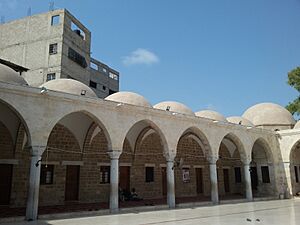
One important landmark is the Great Mosque of Gaza in the Old City. It was first a pagan temple, then a Greek Orthodox church, and later a mosque. The Crusaders turned it back into a church, but it became a mosque again after Muslims retook Gaza. It is the oldest and largest mosque in the Gaza Strip.
Other mosques in the Old City include the Mamluk-era Sayed Hashem Mosque. It is believed to hold the tomb of Hashim ibn Abd al-Manaf. The nearby Kateb al-Welaya Mosque dates back to 1334. In Shuja'iyya is the Ibn Uthman Mosque, built in 1402.
The Unknown Soldier's Square in Rimal is a monument to an unknown Palestinian fighter from the 1948 War. Qasr al-Basha was once a Mamluk-era villa used by Napoleon. Today, it is a girls' school. The Commonwealth Gaza War Cemetery, also called the British War Cemetery, has graves of Allied soldiers from World War I. It is northeast of the city center.
City Services and Infrastructure
Water and Sanitation
In 1997, almost all of Gaza's residents (98.1%) were connected to the public water supply. About 87.6% were connected to a public sewage system. The blockade on Gaza severely limited the city's water supply. Many people did not have regular access to water. The city had to pump water from "salty wells" due to lack of electricity. A lot of untreated sewage flowed into the Mediterranean Sea, causing hygiene problems.
Gaza relies heavily on water from Wadi Ghazza and the Gaza Aquifer. However, most of the water from Wadi Ghazza is sent to Jerusalem.
Electricity in Gaza
In 2002, Gaza started its own power plant. However, it was damaged in 2006. Before this, Israel also provided electricity to Gaza. The plant was partly rebuilt by December 2007, and Israel continues to sell electricity to Gaza.
Waste Management
Managing solid waste is a big challenge in Gaza. This is due to a lack of investment in environmental systems and less focus on environmental projects. A major problem is the huge amount of rubble and debris from bombardments.
For example, the damage from the 2014 Israel–Gaza conflict was huge. Over 2 million tons of debris were created. Many houses were destroyed. A lot of debris remains scattered in Gaza. This requires a lot of effort and money to clean up. In January 2024, Gaza City’s main water reservoirs were also destroyed.
Getting Around Gaza
The Rasheed Coastal Road runs along Gaza's coastline. It connects the city with the rest of the Gaza Strip. The main highway, Salah al-Din Road, goes through the middle of Gaza City. It connects Gaza with other towns to the north and south. The northern crossing into Israel is the Erez Crossing. The crossing into Egypt is the Rafah Crossing.
Omar Mukhtar Street is the main road in Gaza City. Before the Blockade of the Gaza Strip, there were regular shared taxis to other cities. Besides private cars, taxis and buses serve Gaza City.
The Yasser Arafat International Airport near Rafah opened in 1998. Its runways and facilities were damaged in 2001 and 2002, making it unusable.
Gaza's International Connections
Gaza has "twin city" relationships with several cities around the world:
 Tel Aviv, Israel (1998)
Tel Aviv, Israel (1998) Dunkirk, France (1996)
Dunkirk, France (1996) Turin, Italy (1997)
Turin, Italy (1997) Tabriz, Iran
Tabriz, Iran Tromsø, Norway (2001)
Tromsø, Norway (2001) Cascais, Portugal
Cascais, Portugal Barcelona, Spain (1998)
Barcelona, Spain (1998) Cáceres, Spain (2010)
Cáceres, Spain (2010)
See Also
 In Spanish: Gaza para niños
In Spanish: Gaza para niños


